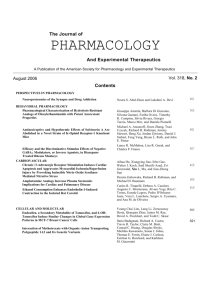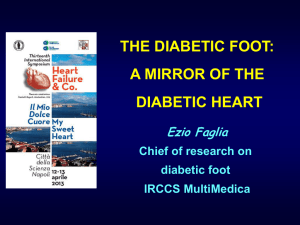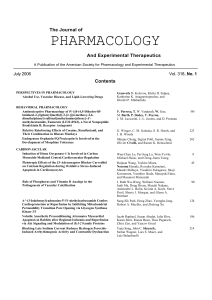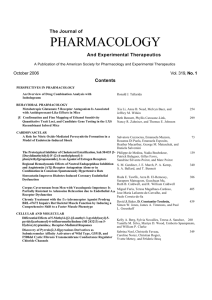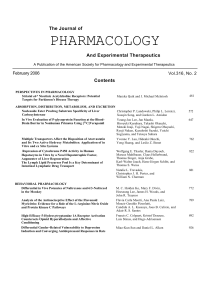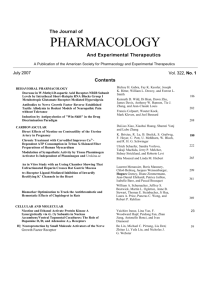Diabetic Mouse (db/db)
advertisement
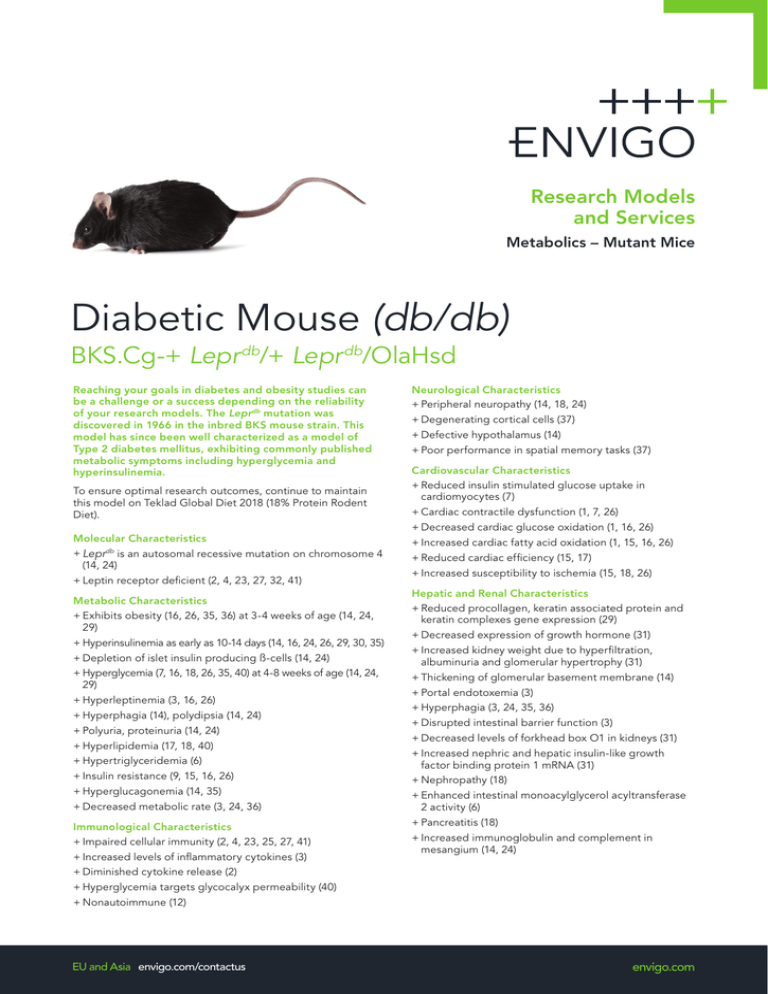
Research Models and Services Metabolics – Mutant Mice Diabetic Mouse (db/db) BKS.Cg-+ Lepr db/+ Lepr db/OlaHsd Reaching your goals in diabetes and obesity studies can be a challenge or a success depending on the reliability of your research models. The Leprdb mutation was discovered in 1966 in the inbred BKS mouse strain. This model has since been well characterized as a model of Type 2 diabetes mellitus, exhibiting commonly published metabolic symptoms including hyperglycemia and hyperinsulinemia. To ensure optimal research outcomes, continue to maintain this model on Teklad Global Diet 2018 (18% Protein Rodent Diet). Molecular Characteristics +Leprdb is an autosomal recessive mutation on chromosome 4 (14, 24) +Leptin receptor deficient (2, 4, 23, 27, 32, 41) Metabolic Characteristics +Exhibits obesity (16, 26, 35, 36) at 3-4 weeks of age (14, 24, 29) +Hyperinsulinemia as early as 10-14 days (14, 16, 24, 26, 29, 30, 35) +Depletion of islet insulin producing ß-cells (14, 24) +Hyperglycemia (7, 16, 18, 26, 35, 40) at 4-8 weeks of age (14, 24, 29) +Hyperleptinemia (3, 16, 26) +Hyperphagia (14), polydipsia (14, 24) +Polyuria, proteinuria (14, 24) +Hyperlipidemia (17, 18, 40) +Hypertriglyceridemia (6) +Insulin resistance (9, 15, 16, 26) +Hyperglucagonemia (14, 35) +Decreased metabolic rate (3, 24, 36) Immunological Characteristics +Impaired cellular immunity (2, 4, 23, 25, 27, 41) +Increased levels of inflammatory cytokines (3) Neurological Characteristics +Peripheral neuropathy (14, 18, 24) +Degenerating cortical cells (37) +Defective hypothalamus (14) +Poor performance in spatial memory tasks (37) Cardiovascular Characteristics +Reduced insulin stimulated glucose uptake in cardiomyocytes (7) +Cardiac contractile dysfunction (1, 7, 26) +Decreased cardiac glucose oxidation (1, 16, 26) +Increased cardiac fatty acid oxidation (1, 15, 16, 26) +Reduced cardiac efficiency (15, 17) +Increased susceptibility to ischemia (15, 18, 26) Hepatic and Renal Characteristics +Reduced procollagen, keratin associated protein and keratin complexes gene expression (29) +Decreased expression of growth hormone (31) +Increased kidney weight due to hyperfiltration, albuminuria and glomerular hypertrophy (31) +Thickening of glomerular basement membrane (14) +Portal endotoxemia (3) +Hyperphagia (3, 24, 35, 36) +Disrupted intestinal barrier function (3) +Decreased levels of forkhead box O1 in kidneys (31) +Increased nephric and hepatic insulin-like growth factor binding protein 1 mRNA (31) +Nephropathy (18) +Enhanced intestinal monoacylglycerol acyltransferase 2 activity (6) +Pancreatitis (18) +Increased immunoglobulin and complement in mesangium (14, 24) +Diminished cytokine release (2) +Hyperglycemia targets glycocalyx permeability (40) +Nonautoimmune (12) EU and Asia envigo.com/contactus envigo.com Research Use +Diabetes mellitus type II (2, 5, 9, 16, 18, 21, 29, 31, 34, 35, 40) Additional Characteristics +Infertility (14, 24) +Diminished growth factor release (2, 29) +Decreased levels of insulin-like growth factor-1 (2, 31) +Increased minor glycosylated hemoglobin (14) +Obesity (6, 19) +Tissue repair (29) +Steatosis (3) +Leptin endocrinology (4, 8, 27, 28, 31, 36, 37) +Leptin treatment (10, 11, 36) +Therapeutics (1, 2, 5, 7, 9, 13, 19, 20, 21, 22, 30, 33, 34, 35, 38, 39) +++++++++++++++++++++++++++++++++++++++++++++++++++++++++ References 1. Aasum, E., Cooper, M., Severson, D. L., & Larsen, T. S. (2005). Effect of BM 17.0744, a PPAR ligand, on the metabolism of perfused hearts from control and diabetic mice. Can J Physiol Pharmacol, 83, 183-190. 2. Anis, Y., Leshem, O., Reuveni, H., Wexler, I., Sasson, R. B., Yahalom, B., et al. (2004). Antidiabetic effect of novel modulating peptides of G-protein-coupled kinase in experimental models of diabetes. Diabetologia, 47, 1232-1244. 3. Brun, P., Castagliuolo, I., Di Leo, V., Buda, A., Pinzani, M., Palù, G., et al. (2007). Increased intestinal permeability in obese mice: New evidence in the pathogenesis of nonalcoholic steatohepatitis. Am J Physiol Gastrointest Liver Physiol, 292, G518-G525. 4. Busso, N. So, A., Chobaz-Péclat, V., Morard, C., MartinezSoria, E., Talabot-Ayer, D., et al. (2002). Leptin signaling deficiency impairs humoral and cellular immune responses and attenuates experimental arthritis. The Journal of Immunology, 168, 875-882. 5. Cao, G., Liang, Y., Broderick, C. L., Oldham, B. A., Beyer, T. P., Schmidt, R. J., et al. (2003). Antidiabetic action of a liver X receptor agonist medicated by inhibition of hepatic gluconeogenesis. The Journal of Biological Chemistry, 278, 1131-1136. 6. Cao, J., Hawkins, E., Brozinick, J., Liu, X., Zhang, H., Burn, P., et al. (2004). A predominant role of acyl-CoA: Monoacylglycerol acyltransferase-2 in dietary fat absorption implicated by tissue distribution, subcellular localization, and up-regulation by high fat diet. The Journal of Biological Chemistry, 279, 18878-18886. 7. Carley, A. N., Semeniuk, L. M., Shimoni, Y., Aasum, E., Larsen, T. S., Berger, J. P., et al. (2004). Treatment of type 2 diabetic db/db mice with a novel PPAR agonist improves cardiac metabolism but not contractile function. Am J Physiol Endocrinol Metab, 286, E449-E455. 8. De Matteis, R., & Cinti, S. (1998). Ultrastructural immunolocalization of leptin receptor in the mouse brain. Neuroendocrinology, 68, 412-419. 9. del Rey, A., & Besedovsky, H. (1989). Antidiabetic effects of interleukin 1. PNAS, 86, 5943-5947. 10.Dulloo, A. G., Stock, M. J., Solinas, G., Boss, O., Montani, J.-P., & Seydoux, J. (2002). Leptin directly stimulates thermogenesis in skeletal muscle. FEBS Letters, 25896, 109-113. 11. Emilsson, V., Liu, Y.-L., Cawthorne, M. A., Morton, N. M., & Davenport, M. (1997). Expression of the functional leptin receptor mRNA in pancreatic islets and direct inhibitory action of leptin on insulin secretion. Diabetes, 46, 313-316. 12.Fan, H., Longacre, A., Meng, F., Patel, V., Hsiao, K., Koh, J. S., et al. (2004). Cytokine dysregulation induced by apoptotic cells is a shared characteristic of macrophages from nonobese diabetic and systemic lupus erythematosus-prone mice. The Journal of Immunology, 172, 4834-4843. 13.García-Vincente, S., Yraola, F., Marti, L., González-Muñoz, E., García-Barrado, M. J., Cantó, C., et al. (2007). Oral insulin-mimetic compounds that act independently of insulin. Diabetes, 56, 486-493. 14.Green, M. C. (1981). Genetic Variants and Strains of the Laboratory Mouse. Stuttgart, NY: Gustav Fischer Verlag. 15.Hafstad, A. D., Khalid, A. M., How, O.-J., Larsen, T. S., & Aasum, E. (2007). Glucose and insulin improve cardiac efficiency and postischemic functional recovery in perfused hearts from type 2 diabetic (db/db) mice. Am J Physiol Endocrinol Metab, 292, 1288-1294. 29.Rodgers, K. E., Ellefson, D. D., Espinoza, T., Hsu, Y-h., diZerega, G. S., & Mehrian-Shai, R. (2006). Expression of intracellular filament, collagen, and collagenase genes in diabetic and normal skin after injury. Wound Rep Reg, 14, 298305. 16.Hafstad, A. D., Solevåg, G. H., Severson, D. L., Larsen, T. S., & Aasum, E. (2006). Perfused hearts from Type 2 diabetic (db/db) mice show metabolic responsiveness to insulin. Am J Physiol Heart Circ Physiol, 290, H1763-H1769. 30.Schneider, J. G., Finck, B. N., Ren, J., Standley, K. N., Takagi, M., Maclean, K. H., et al. (2006). ATM-dependent suppression of stress signaling reduces vascular disease in metabolic syndrome. Cell Metabolism, 4, 377-389. 17. How, O-J., Aasum, E., Severson, D. L., Chan, W. Y. A., Essop, M. F., & Larsen, T. S. (2006). Increased myocardial oxygen consumption reduces cardiac efficiency in diabetic mice. Diabetes, 55, 466-473. 31.Segev, Y., Eshet, R., Yakir, O., Haim, N., Phillip, M., & Landau, D. (2007). Systemic and renal growth hormoneIGF1axis involvement in a mouse model of type 2 diabetes. Diabetologia, 50, 1327-1334. 18.Jones, S. P., Girod, W. G., Granger, D. N., Palazzo, A. J., & Lefer, D. J. (1999). Reperfusion injury is not affected by blockade of P-selectin in the diabetic mouse heart. Am J Physiol Heart Circ Physiol, 277, 763-769. 32.Slieker, L. J., Sloop, K. W., Surface, P. L., Kriauciunas, A., LaQuier, F., Manetta, J., et al. (1996). Regulation of expression of ob mRNA and protein by glucocorticoids and cAMP. The Journal of Biological Chemistry, 271, 5301-5304. 19. Kast-Woelbern, H. R., Dana, S. L., Cesario, R. M., Sun, L., de Grandpre, L. Y., Brooks, M. E., et al. (2004). Rosiglitazone induction of Insig-1 in white adipose tissue reveals a novel interplay of Peroxisome Proliferatoractivated Receptor and sterol regulatory element-binding protein in the regulation of adipogenesis. The Journal of Biological Chemistry, 279, 23908-23915. 33.Sloop, K. W., Cao, J. X-C., Siesky, A. M., Zhang, H. Y., Bodenmiller, D. M., Cox, A. L., et al. (2004). Hepatic and glucagon-like peptide-1-mediated reversal of diabetes by glucagon receptor antisense oligonucleotide inhibitors. The Journal of Clinical Investigation, 113, 1571-1581. 20.Kharitonenkov, A., Shiyanona, T. L., Koester, A., Ford, A. M., Micanovic, R., Galbreath, E. J., et al. (2005). FGF-21 as a novel metabolic regulator. The Journal of Clinical Investigation, 115, 1627-1635. 34.Sloop, K. W., Showalter, A. D., Cox, A. L., Cao, J. X. C., Siesky, A. M., Zhang, H. Y., et al. (2007). Specific reduction of hepatic glucose 6-phosphate transporter-1 ameliorates diabetes while avoiding complications of glycogen storage disease. The Journal of Biological Chemistry, 282, 19113-19121. 21.Kim, S. H., Hyun, S. H., & Choung, S. Y. (2006). Antidiabetic effect of cinnamon extract on blood glucose in db/db mice. Journal of Ethnopharmacology, 104, 119-123. 35.Strowski, M. Z., Cashen, D. E., Birzin, E. T., Yang, L., Singh, V., Jacks, T. M., et al. (2006). Antidiabetic activity of a highly potent and selective nonpeptide Somatostatin Receptor subtype-2 agonist. Endocrinology, 147, 4664-4673. 22.Kim, S. H., Hyun, S. H., & Choung, S. Y. (2006). Antioxidative effects of Cinnamomi cassiae and Rhodiola rosea extracts in liver of diabetic mice. BioFactors, 26, 209-219. 36.Takahashi, N., Waelput, W., & Guisez, Y. (1999). Leptin is an endogenous protective protein against the toxicity exerted by Tumor Necrosis Factor. J Exp Med, 189, 207-212. 23.Lord, G. M., Matarese, G., Howard, J. K., Baker, R. J., Bloom, S. R., & Lechler, R. I. (1998). Leptin modulates the T-cell immune response and reverses starvation-induced immunosuppression. Nature, 394, 897-901. 37. Valerio, A., Ghisi, V., Dossena, M., Tonello, C., Giordano, A., Frontini, A., et al. Leptin increases axonal growth cone size in developing mouse cortical neurons by convergent signals inactivating Glycogen Synthase Kinase-3ß. The Journal of Biological Chemistry, 281, 12950-12958. 24.Lyon, M. F., Rastan, S., & Brown, S. D. M. (Eds.). (1996). Genetic Variants and Strains of the Laboratory Mouse (3rd Ed.) (Vol. 2). New York: Oxford University Press. 25.Matarese, G., Carrieri, P. B., la Cava, A., Perna, F., Sanna, V., de Rosa, V., et al. (2005). Leptin increase in multiple sclerosis assocites with reduced number of CD4+ CD25+ regulatory T cells. PNAS, 102, 5150-5155. 26.Oakes, N. D., Thalén, P., Aasum, E., Edgley, A., Larsen, T., Furler, S. M., et al. (2006). Cardiac metabolism in mice: Tracer method developments and in vivo application revealing profound metabolic inflexibility in diabetes. Am J Physiol Endocrinol Metab, 290, 870-881. 27. Papathanassglou, E., El-Haschimi, K., Li, X. C., Matarese, G., Strom, T., & Mantzoros, C. (2006). Leptin receptor expression and signaling in lymphocytes: Kinetics during lymphocyte activation, role in lymphocyte survival, and response to high fat diet in mice. The Journal of Immunology, 176, 7745-7752. 28.Pralong, F. P., Roduit, R., Weber, G., Castillo, E., Mosimann, F., Thorens, B., et al. (1998). Leptin inhibits directly glucocorticoid secretion by normal human and rat adrenal gland. Endocrinology, 139, 4264-4268. 38.Wente, W., Efanov, A. M., Brenner, M., Kharitonenkov, A., Köster, A., Sandusky, G. E., et al. (2006). Fibroblast growth factor-21 improves pancreatic ß-Cell function and survival by activation of Extracellular Signal-Regulated Kinase ½ and Akt signaling pathways. Diabetes, 55, 2470-2478. 39.Xu, Y., Etgen, G. J., Broderick, C. L., Canada, E., Gonzalez, I., Lamar, J. (2006). Design and synthesis of dual peroxisome proliferator-activated receptors and agonists as novel euglycemic agents with a reduced weight gain profile. J Med Chem, 49, 5649-5652. 40.Zuurbier, C. J., Demirci, C., Koeman, A., Vink, H., & Ince, C. (2005). Short-term hyperglycemia increases endothelial glycocalyx permeability and acutely decreases lineal density of capillaries with flowing red blood cells. J Appl Physiol, 99, 1471-1476. 41. Zykova, S. N., Jenssen, T. G., Berdal, M., Olsen, R., Myklebust, R., & Seljelid, R. (2000). Altered cytokine and nitric oxide secretion in vitro by macrophages from diabetic type II-like db/db mice. Diabetes, 49, 1451-1458. Contact us EU and Asia envigo.com/contactus Envigo RMS Division, 8520 Allison Pointe Blvd., Suite 400, Indianapolis, IN 46250, United States © 2016 Envigo. RMS-0116-EU-01-DS-5193
